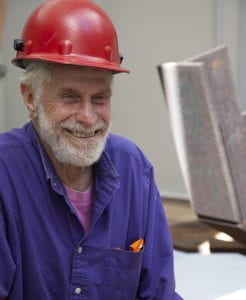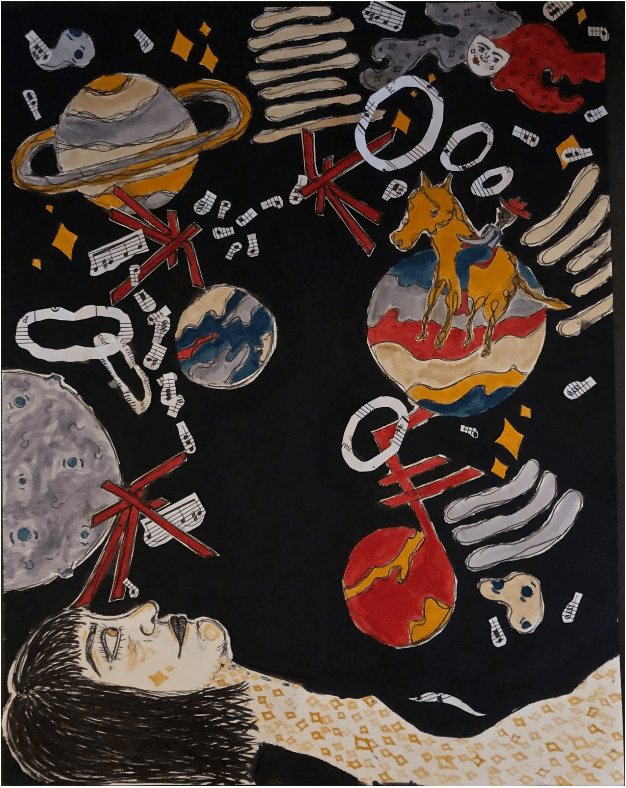About the Artist:
Di Suvero is originally from Shanghai, China. He immigrated to the states roughly ten years after he was born. Di Suvero and his family immigrated to San Francisco, California, following the outbreak of WWII. He began sculpting in college, as he attended UCSB followed by UC Berkeley. While he got his B.A. in philosophy, he eventually realized that his career in sculpting would be more meaningful, and moved to New York to pursue art. Di Suvero has won a number of awards, including the Heinz Award in 2005, the National Medal of Arts in 2010, and the American Academy of Arts and Letters Gold Medals in 2013. His works often include elements of movement and flowing composition. Di Suvero’s sculptures are situated in a variety of landscapes, but always manage to add to and become one within their surroundings.
Our Thoughts and Reaction:
As with all of his works, the idea of space and surrounding is a vital part of For Handel’s composition. For Handel is a tribute piece dedicated to the composer George Frideric Handel, so it’s no surprise that di Suvero chose to place this piece directly in front of Western’s Performing Arts Center and right above the rehearsal hall. Another intent of his was to reflect the ability that people have to interact with music in the sculpture itself. This concept of interaction is evident in the long girders that run along the ground, inviting students to sit, walk across, or even climb up the sculpture. Interaction with the sculpture is a huge part of the function of the piece and helps it to fit perfectly in its place.
Our Reinterpretation:
Our reinterpretation is centered around three core ideas that Mark di Suvero focused on while creating his sculpture, For Handel. Movement, music, and reflections of culture and time period are all focal points in the enormous sculpture. Our group ensured that we utilized these values in our re-interpretation.
Movement:
In all of di Suvero’s sculptures, movement is what’s at play. Shapes colliding with other shapes are the basis of all of his sculptures. These shapes then interacting with their backgrounds, and the world around them, are what give his sculptures meaning. While it may appear busy at first, our art does what di Suvero’s does, in that a web is unraveled with time. You can detect movement in all elements of our art piece, but especially in the movement of the spaceship, which we created out of a drawn miniature version of the sculpture itself.
Music:
Since di Suvero created this sculpture for George Frideric Handel, it was clear that music was di Suvero’s guiding hand. The sheet music used in our piece is taken from a song composed by Handel. It is also what guides the miniature version of the sculpture in our piece, through the atmosphere. The lasso of the cowboy, which is made of sheet music, has effectively captured the spaceship. This represents the power and importance that di Suvero believes music has.
Reflection of Culture and Time Period:
Built in 1975, it is of no argument that For Handel was built in one of the most definitive and divisive times in American history. 1975 was the year the Vietnam war ended, and marked the last of the Apollo missions. While it was a year of endings, it also marked the beginning of a new American culture, which was based around exploration and freedom of thought. Revolution was brewing and change was happening rapidly. The sculpture, For Handel, captures both growth, with it’s bright red color and massive size, as well as endings. It’s placement is situated at the end of campus, and looks out onto the peaceful bay and bustling city of Bellingham, representing the end of our campus and the beginnings of the whole city which lies before us. This can be seen in our piece, first and foremost, by the woman at the bottom. She is depicted looking with both amazement and wonder at the scene in front of her. Made up of stars, her neck fades into the scene itself, representing the ending of her and the beginning of the vast atmosphere in front of her. We included an acknowledgement of the time period in our piece as well. The space cowboy represents the culture of the 1970’s, best seen in the prominence of David Bowie, and the rising counter-culture filled with “hippies.” The depiction of space itself can most obviously be attributed to the Apollo missions, but also to the vastness of it all, which allows for exploration and change.
All members of the group met up to make this, and worked collaboratively with ideas and concepts. We all drew the planets together and stars together. Dylan and Sean worked to cut out the sheet music while Maggie worked on painting the background and the womans face. Maggie drew and cut out the miniature version of the sculpture, For Handel, and worked to draw out the path that it would take. We all then went back and placed the musical notes and sheet music, as well as filled in any gaps as a team.
Bibliography:
Di Suvero, Mark, and Barré, François. Mark Di Suvero : Dreambook. Berkeley: U of California, 2008. Print.
Pearson, Steve. “What Happened in 1975 Important News and Events, Key Technology and Popular Culture.” The People History, www.thepeoplehistory.com/1975.html.
Ragain, Melissa. “Kinetics of Liberation in Mark Di Suvero’s Play Sculpture.” American Art 31.3 (2017): 26-51. Web.
Mark Di Suvero, SpaceTimecc: “About The Artist”. SpaceTimecc, http://www.spacetimecc.com/about/
“React. Research. Execute!” React Research Execute,
wp.wwu.edu/wwuart109/2018/11/08/for-handel-art-for-the-artist/.
“React. Research. Execute!” React Research Execute,
wp.wwu.edu/wwuart109/2018/03/01/for-handle-we-see/.
By:
Maggie Ebel
- Reinterpretation Piece
- Artist and Artwork Background Research
- Various Writing
Dylan Gappa
- Group Admin/Blog Formatting
- Reinterpretation Piece
- Artist and Artwork Background Research
- Various Writing
Sean Kilkenny
- Reinterpretation Piece
- Artist and Artwork Background Research
- Various Writing



Leave a Reply